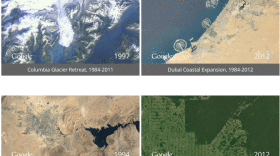Earlier this week, I posted on the power of Google's "Earth Engine," an online tool that lets you fly back in time and space to see how land has changed.
Watching these changes can be a bit depressing. Asphalt sprouts up and trees come down for sprawling suburbs. Glaciers recede. Rainforests come down.
But it's not all depressing. Places can come back.
In the limited scans I did over Michigan, I saw one area go from what seemed like a denuded industrial site, to a greened-up island.
You can watch the transition here.
Turns out, it's Canada's Fighting Island in the Detroit River. And it's an environmental success story.
An entire island used to dump waste
The Michigan Alkali Company bought Fighting Island in 1918 and used it to deposit waste. The company made soda ash, lye, and baking soda from the salt deposits under the area.
There were several waste "tailing beds" on the island, the last of which was shut down in 1982.
Tina Lam of the Detroit Free Press reported in 2009 that 80% of the island was once "covered with 20 million cubic yards of highly acidic brine waste dumped there from a soda ash plant."
Lam described how pale dust would blow off the island leading to complaints from nearby communities.
BASF greens up the island
The German chemical company BASF owns the island today and has been replanting it since the last tailing bed was shut down.
In 2005, the company was recognized with an award from the Wildlife Habitat Council.
BASF has planted more than 200,000 seedlings, including poplar, Russian olive and native berry bushes. By 1982, 30 percent of the beds were covered with vegetation; today approximately 80 percent of the island is covered with vegetation.
So it's a reversal.
A place where vegetation is expanding rather than declining.
BASF has a partnership with the local school district to educate kids on the island. They come and learn about changing ecosystems and natural restoration.
Don Fay, a science consultant for the Greater Essex County District School Board, says the kids experience a new dimension of learning when they visit Fighting Island:
"Because now they are seeing that they can solve problems - that nothing is hopeless - that their applied knowledge can actually yield true benefits that they can see year after year when they come back to the island."
Here's the video about the partnership:
http://youtu.be/xeM6nVxD3nE
In 2009, a BASF representative said this about the island in the Windsor Star:
"It's beyond gratifying," said DeLisle, facilities manager for BASF. "I've got deer running and coyotes running and boy scouts planting trees. It's good stuff."
The island fits in with Congressman Dingell's effort to restore habitat in the Detroit River. While it's not a part of the Detroit River International Wildlife Refuge, it sits right next to it. If we're able to use the "Earth Engine" 20 years from now, perhaps we'll see even more green in this part of the Detroit River.




